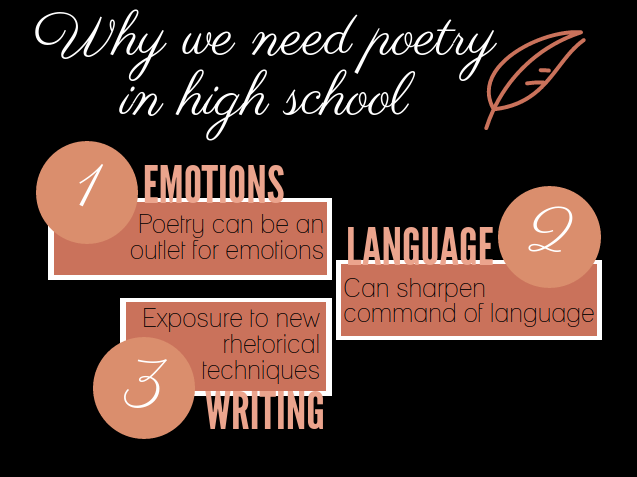Too powerful to ignore: the importance of learning to write poetry
April 3, 2017
The first time I wrote a poem was during a free write in sixth grade. I was sitting in Ms. Goldman’s English class, under the windows, in the sun. I don’t remember the poem I wrote, but I do remember how powerful it made me feel.
For the first time, I had an outlet for the confusing feelings most prepubescent girls experience. After months of poetry free writes, I began to see improvement in my ability to articulate myself and understand my emotions.
Other writers have attested to these benefits. Renowned poet Anna Maria Hong called the process of writing poetry “one of the best tools we have for knowing what we think and what we really feel.” She emphasized its unique power to assist us as we “process experience,” which is “often difficult for young adults.”
But despite the many emotional and academic benefits of writing poetry, it hasn’t been addressed once in my five semesters of high school English. Teachers, curriculum writers and county officials should consider adding lessons and units focused on writing poetry to fill this gap in instruction.
Poetry facilitates the expression of adolescents’ raw emotions. Editing these poems also forces students to reflect on difficult feelings, which helps them process them and is a valuable life skill. I have also found that sharing completed poems—the final step in the poetic process—never fails to foster empathy between individuals, and could create kinder in and out school communities.
Through poetry, students can gain exposure to new forms of writing and rhetorical techniques. Poetry is the ideal format to practice using new devices, and over time, they become second nature. In sixth and seventh grade, I started writing poetry with basic figurative language: metaphor, simile, alliteration, imagery. Later, I experimented with capitalization, line breaks, and varying rhyme schemes. Recently, I have played with the sounds of words themselves, from homophones to assonance.
Poetry’s informal structure is often accessible and enjoyable to students who struggle with academic writing, according to a 2014 Atlantic article by high school English teacher Andrew Simmons. Poetry can act as a “gateway to other forms of writing” and teach essential writing techniques, such as precise diction.
Despite little formal instruction on the subject, I kept writing poetry throughout middle school, and have continued in high school. And I’m so glad that I did. Poetry has allowed me to navigate the challenges of adolescence, from fraught friendships:
“…heart aching,
hot tears streaming
breath coming
in short,
desperate
gasps…”
(2013)
to love:
“…i think that there might
be a butterfly trapped inside of me
and when we talk
it’s like coming up for air…”
(2015)
and womanhood:
“and i faltered, naked—
as the bees shed their stingers
before me and took up
nouns as a weapon,
i laughed and became
a sword,
sleeping under
her pillow, just in case…”
(2016)
and much, much more.
Out of all these words, the words of the 200 poems I have written in the past six years, a semblance of my identity has begun to form.
Poetry has been essential to my development as a writer and a human; all high school students should be offered the same opportunities to experiment with emotions and language as they grow and develop into adults, and to reap the lifelong benefits.









